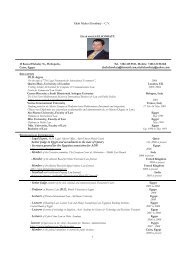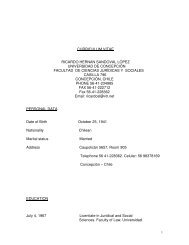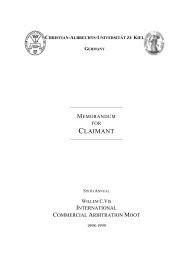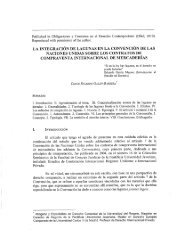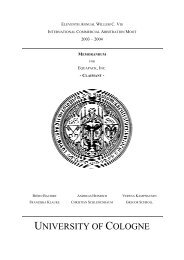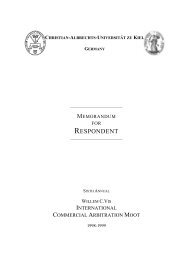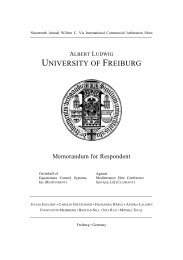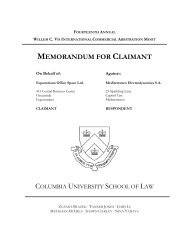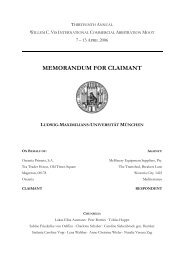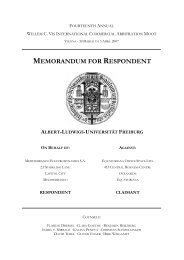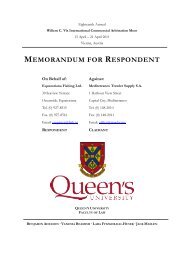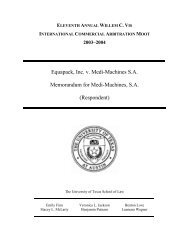memorandum for respondent ludwig-maximilians-universität münchen
memorandum for respondent ludwig-maximilians-universität münchen
memorandum for respondent ludwig-maximilians-universität münchen
Create successful ePaper yourself
Turn your PDF publications into a flip-book with our unique Google optimized e-Paper software.
LUDWIG-MAXIMILIANS-UNIVERSITÄT MÜNCHEN<br />
Article 32 (1) 1 st 4<br />
Alt. CIDRA-AR. The agreement between the parties neither contains an explicit<br />
reference to the UN-Limitation Convention, nor an implied choice.<br />
An implied designation of law requires a rather unambiguous choice by the parties<br />
(PELLONPÄÄ/CARON p. 82) appearing clearly from the contract itself, as well as from its<br />
surrounding circumstances (LANDO RABELSZ p. 65). The lack of the parties’ will to designate the<br />
UN-Limitation Convention already results from the absence of an express reference in the<br />
contract, as the parties clearly intended to prevent legal uncertainty. They designated arbitration<br />
rules, an arbitral <strong>for</strong>um and the CISG to govern the substance of potential disputes (Cl. Exh.<br />
No. 7 §§ 12, 13). Particularly the express choice of the CISG – which would have been applicable<br />
even without the parties’ designation (Statement of Claim § 14) – demonstrates their intent to<br />
effectuate clear choices of law by inclusion in the contractual document. Had the parties<br />
intended to apply the UN-Limitation Convention, they would certainly have designated it in an<br />
express manner. There is a “certain artificiality involved” when a substantive law is found to<br />
have been selected through a tacit choice of the parties (REDFERN/HUNTER § 2-76). This is<br />
especially apparent when the parties have given little or no thought to the question of the law<br />
applicable (ibid.). By applying a law which the parties have ignored, excess of arbitral authority<br />
can be established (CARBONNEAU p. 33) and the award is likely to be set aside (KLEIN p. 198;<br />
MANN p. 171).<br />
5 Furthermore, the application of the UN-Limitation Convention cannot be inferred from the<br />
parties’ designation of the CISG – as asserted by CLAIMANT (Cl. Memorandum § 93) – since the<br />
Conventions lack the alleged close affiliation. They were drafted in different places and different<br />
years – the UN-Limitation Convention in New York in 1974 (Introductory Note to the UN-Limitation<br />
Convention § 1) and the CISG in Vienna in 1980 (GIRSBERGER p. 157). Moreover, the number of<br />
their members varies considerably – the CISG having been ratified by 66<br />
(http://www.uncitral.org/uncitral/en/uncitral_texts/sale_goods/1980CISG_status.html), the UN-<br />
6<br />
Limitation Convention merely by 19 countries (http://www.uncitral.org/uncitral/en/uncitral_texts/<br />
sale_goods/ 1974Convention_status.html) – indicating that the provisions of the <strong>for</strong>mer were easier to<br />
agree on than those of the latter (SONO § 2 A). Above all, the drafters’ restraint from unifying the<br />
Conventions when the UN-Limitation Convention was amended in 1980 clearly demonstrates<br />
their intent to maintain the CISG as a separate and independent convention. Thus, the parties’<br />
choice of the CISG does not constitute an implied designation of the UN-Limitation Convention.<br />
CLAIMANT’s allegation that the UN-Limitation Convention’s prescription period of four<br />
years is representative of an international consensus (Cl. Memorandum §§ 93 et seq.) cannot be<br />
upheld. This period exceeds the length of prescription under many national laws and is<br />
3



